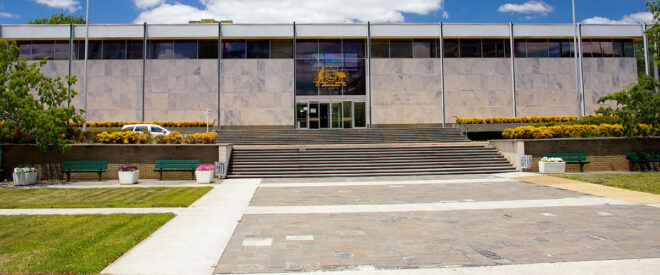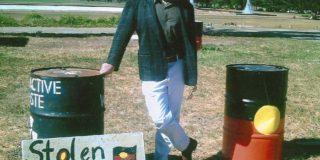
Preamble
Yesterday, I reflected on the tragic death of Kumanjayi Walker, a 19-year-old Warlpiri-Luritja man, during a police operation in Yuendumu on November 9, 2019. The subsequent acquittal of Constable Zachary Rolfe and the findings of a coronial inquest led by NT Coroner Elisabeth Armitage have shed light on systemic issues of racism and excessive use of force within the police force. This case is particularly poignant given Constable Rolfe’s background; he hails from a prominent and well-to-do family in the Australian Capital Territory (ACT).
My personal connection to the Australian Federal Police (AFP) traces back to a public interest disclosure (PID) allegedly submitted by ACT public servant Angel Marina in December 2003. The investigation into Mr. Marina’s disclosure was led by Constable Rowena Penfold, who, under oath, admitted to failing to adhere to AFP procedures regarding the documentation from a raid she conducted. Alarmingly, during this operation, Constable Penfold not only turned off the recording device multiple times, but also made racially charged comments directed at an Indigenous person present, who was not even the focus of the investigation. Despite these serious allegations, Constable Penfold has recently been promoted to Acting Commander within the AFP, a move that raises significant concerns about accountability and the consequences of professional misconduct.
The failure to properly investigate Mr. Marina’s PID, coupled with the racially biased conduct exhibited by Constable Penfold, has led to over two decades of attempts by an Indigenous family to seek justice. The ACT Labor Government has been complicit in this ongoing persecution, undermining the Territory’s human rights legislation and highlighting the urgent need for reform.
Introduction
The over-representation of Indigenous Australians in the criminal justice system is a persistent and deeply troubling issue, reflecting historical injustices, systemic biases and socioeconomic disparities. In the ACT, where policing is conducted by the AFP, Indigenous incarceration rates remain disproportionately high, despite the Territory’s progressive reputation. Indigenous people, constituting approximately 2% of the ACT’s population, account for around 26% of its prison population. Nationally, Indigenous Australians represent 3% of the population but nearly 30% of prisoners, with an age-standardised imprisonment rate of 2,151.1 per 100,000 adults in 2022, compared to 151 per 100,000 for non-Indigenous adults. In the ACT, the Indigenous incarceration rate stands at approximately 1,826.1 per 100,000, which, while lower than the national average, is still 16.8 times higher than that of non-Indigenous individuals.
This essay explores the factors contributing to these disparities in the ACT, focusing on the role of the AFP, systemic bias within the justice system and the lack of accountability for non-Indigenous public servants, particularly in cases involving perjury. Drawing on my personal experience of being charged with 16 counts by ACT Policing – charges that were ultimately beaten in the ACT Supreme Court – I argue that the system’s bias against Indigenous people, combined with the impunity of non-Indigenous actors, significantly skews incarceration statistics and perpetuates injustice.
Historical and Structural Context
Understanding the over-representation of Indigenous Australians in the criminal justice system requires acknowledgment of the legacy of colonialism. Policies such as terra nullius, the Stolen Generations and forced segregation have disrupted Indigenous kinship systems, dispossessed communities of their land and entrenched intergenerational trauma. These historical injustices have manifested in contemporary socioeconomic disadvantages, including poverty, limited access to education and poor health outcomes, all of which correlate with higher incarceration rates.
The Royal Commission into Aboriginal Deaths in Custody (RCIADIC) in 1991 identified these underlying factors, stating that “the most significant contributing factor bringing Aboriginal people into conflict with the criminal justice system was their disadvantaged and unequal position in the wider society.” In the ACT, these systemic issues are compounded by the unique policing arrangement where the AFP, a federal agency, handles both community policing and national security duties, potentially leading to conflicts of interest and inconsistent application of discretion.
The ACT’s justice system operates within a broader national context where Indigenous Australians face structural barriers at every stage of the criminal justice process, from policing to sentencing. The Australian Law Reform Commission (ALRC) in 2018 reported that Indigenous people are 12.5 times more likely to be imprisoned than non-Indigenous people, with Indigenous women facing even greater disparities, being 21.2 times more likely to be incarcerated. Although the Galambany Circle Sentencing Court, established in 2004, aims to reduce recidivism by involving Indigenous communities in sentencing, its impact is limited by systemic issues such as over-policing and inadequate funding for diversion programs. The National Agreement on Closing the Gap, which includes a target to reduce Indigenous adult incarceration by 15% by 2031, has seen little progress, with the ACT’s Indigenous incarceration rate remaining stubbornly high.
Indigenous Incarceration in the ACT: Statistical Overview
In 2022, the ACT’s Indigenous incarceration rate was approximately 1,826.1 per 100,000 adults, compared to 108.7 per 100,000 for non-Indigenous adults, resulting in an over-representation ratio of 16.8. While this is lower than the national Indigenous rate of 2,558.9 per 100,000, it still reflects significant disparities. Indigenous prisoners in the ACT are more likely to be charged with offences such as acts intended to cause injury (38%) and offences against justice procedures (9%), often linked to socioeconomic stressors rather than inherent criminality.
The Alexander Maconochie Centre, the ACT’s primary prison, houses a disproportionate number of Indigenous inmates, with 26% of its population identifying as Aboriginal or Torres Strait Islander despite their small demographic share. Youth incarceration is equally concerning; in 2021–22, Indigenous young people aged 10–17 in the ACT were 24 times more likely to be in detention than their non-Indigenous peers, reflecting early entry into the justice system that often leads to lifelong cycles of incarceration. The ACT’s Warrumbul Circle Sentencing Court for young offenders seeks to address this, but its reach is limited. These statistics highlight the systemic nature of Indigenous over-representation, driven by factors such as over-policing, racial profiling and limited access to culturally appropriate legal support.
The Role of the Australian Federal Police
The AFP’s dual role as both a national security agency and the ACT’s community policing force creates unique challenges. Unlike state police forces, the AFP operates under federal oversight, which can lead to a disconnect from local community needs. Research by the Human Rights Law Centre and Change the Record Coalition has pointed to biases in police discretion, noting that Indigenous people, particularly young people and women, are less likely to be cautioned or diverted and more likely to be arrested and charged. In the ACT, allegations of over-policing in Indigenous communities, such as the targeting of Indigenous youth in Canberra’s suburbs, have raised concerns about systemic racism within the AFP.
The AFP’s enforcement patterns contribute significantly to Indigenous incarceration rates. For instance, Operation Morpheus, a national AFP-led initiative targeting organised crime, has been criticised for disproportionately affecting marginalised communities, including Indigenous groups, due to its broad surveillance tactics. In the ACT, incidents of over-policing, such as the frequent stop-and-search of Indigenous youth, have been documented, fostering distrust and escalating minor encounters into formal charges. The Yoorrook Justice Commission in Victoria has highlighted similar issues, noting that police discretion often reflects unconscious bias or unequal application of power – a pattern likely applicable to the AFP in the ACT.
Personal Experience: A Case Study in Systemic Bias
My personal experience with the ACT justice system underscores the systemic bias against Indigenous individuals. In 2015, I was charged by ACT Policing with 16 serious allegations stemming from a dispute that escalated due to my Indigenous identity and activism, particularly my family’s involvement with the Aboriginal Tent Embassy. As a close relative of Aunty Isobel Coe and her partner Billy Craigie, prominent figures in the Embassy’s history, I have long been a target of scrutiny in Canberra’s political landscape, where the ACT Labor Government’s quarter-century of one-party rule has entrenched a culture lacking in accountability.
The charges against me were not only baseless, they were rooted in racism and bias, yet the AFP pursued them aggressively, reflecting a pattern of over-charging Indigenous individuals to secure convictions. Had I not had the resources to mount a robust defence, I could have easily become another statistic in the ACT’s Indigenous incarceration figures, likely facing a sentence of eight years or more. The case proceeded to the ACT Supreme Court, where all 16 counts were defeated in a jury trial, meaning that 12 jurors voted 16 times to acquit, meaning that members of the jury decided 192 separate times that the AFP had failed to make its case – a rare victory for an Indigenous defendant. However, the ordeal revealed deeper issues within the system. During my trial, multiple ACT Government employees provided false testimony under oath, committing perjury, a serious crime under Section 703 of the Criminal Code 2002 (ACT). Despite clear evidence of their misconduct, none of these public servants faced charges, highlighting a stark double standard.
This impunity for non-Indigenous actors, particularly public servants, skews incarceration statistics. While Indigenous individuals are charged “at the drop of a hat” for minor offences, non-Indigenous perpetrators, especially those within the public service, often escape accountability. The failure to prosecute perjury in my case is not an isolated incident but part of a broader pattern where the justice system protects its own, perpetuating the over-representation of Indigenous people in prisons. The ACT’s small, interconnected public service, coupled with its long-standing Labor government, fosters a culture where loyalty to the system overrides justice, leaving Indigenous defendants disproportionately vulnerable.
Perjury and the Lack of Accountability
Perjury, defined as wilfully giving false evidence under oath, is a serious offence punishable by up to seven years’ imprisonment. In the ACT Supreme Court, where cases like mine are heard, perjury undermines the integrity of the judicial process. Yet, the absence of charges against ACT Government employees who lied in my case reflects a systemic failure to hold non-Indigenous actors accountable. This contrasts sharply with the AFP’s swift action against Indigenous individuals, who face charges for lesser offences with minimal evidence.
The lack of accountability for perjury has significant implications for incarceration statistics. When non-Indigenous public servants escape prosecution, it artificially inflates the proportion of Indigenous offenders in the system, as their crimes are over-pursued while others are ignored. This double standard reinforces the perception that the justice system is biased against Indigenous people, eroding trust in institutions like the AFP and the ACT Supreme Court. The ALRC’s 2018 report on Indigenous incarceration noted that “structural bias or discriminatory practices within the justice system” contribute to over-representation and the impunity for perjury is a clear example of such bias.
Systemic Bias and Its Impact on Statistics
The systemic bias against Indigenous people in the ACT’s justice system manifests in several ways, all contributing to inflated incarceration rates. First, over-policing and racial profiling by the AFP result in higher arrest rates for Indigenous individuals, often for low-level offences like public intoxication or minor theft. Investigation by The Guardian Australia into cannabis possession charges has found that Indigenous people are four times less likely to receive cautions and more likely to face court – an alarming trend likely present in the ACT.
Second, Indigenous defendants face harsher treatment at the prosecutorial and sentencing stages, with bail often denied due to socioeconomic factors such as unstable housing. Third, the lack of culturally appropriate legal services and diversion programs limits opportunities for rehabilitation, trapping Indigenous individuals in a cycle of incarceration.
The impunity enjoyed by non-Indigenous public servants, as seen in my case, exacerbates these disparities. When perjury goes unpunished, it not only undermines justice but also distorts statistical comparisons. Indigenous incarceration rates appear higher because the system selectively enforces laws against marginalised groups while shielding privileged actors. This selective enforcement is evident in national cases like the 2019 AFP raids on journalists Annika Smethurst and the ABC, where no charges were laid, contrasting sharply with the AFP’s aggressive pursuit of Indigenous defendants.
Addressing the Crisis: Pathways to Reform
Reducing Indigenous incarceration rates in the ACT requires a multifaceted approach that addresses both systemic bias and the lack of accountability for non-Indigenous actors. First, the AFP must undergo cultural reform to eliminate racial profiling and over-policing. Training in cultural awareness, similar to what has been implemented by Victoria Police (with 57.9% of officers trained by 2023), should be expanded in the ACT, alongside stricter oversight of police discretion.
Second, the ACT Government should establish an independent Federal Police Oversight Commission to investigate allegations of bias and ensure accountability, particularly in cases involving Indigenous communities. Third, the justice system must prioritise diversion programs and restorative justice. The Galambany and Warrumbul Circle Sentencing Courts have shown promise, with studies indicating that participants are 52% less likely to be incarcerated and 9.6% less likely to reoffend. Expanding these programs and funding Indigenous-led initiatives, such as the Yallum Yallum Elders and Respected Persons Council in Victoria, could significantly reduce recidivism in the ACT.
Fourth, prosecuting perjury and other crimes committed by public servants is essential to restoring trust and balancing the scales of justice. The ACT Integrity Commission, established in 2019, could play a vital role in investigating such misconduct, but its powers must be strengthened to ensure successful prosecutions. Finally, addressing socioeconomic disparities is critical. The National Agreement on Closing the Gap emphasises education, employment and health as key drivers of incarceration. In the ACT, initiatives like the Aboriginal and Torres Strait Islander Agreement aim to improve outcomes, but progress remains slow. Investing in culturally safe healthcare, affordable housing and education for Indigenous communities could break the cycle of disadvantage that fuels incarceration.
Conclusion
The over-representation of Indigenous Australians in the ACT’s criminal justice system, policed by the AFP, starkly reflects systemic bias, historical injustices and unequal accountability. My personal experience of facing 16 baseless charges, all defeated in the ACT Supreme Court, highlights the ease with which Indigenous individuals are targeted. The failure to prosecute ACT government employees for perjury reveals the system’s protection of non-Indigenous actors. These dynamics skew incarceration statistics, making Indigenous over-representation appear inevitable when it is, in fact, a product of structural flaws.
By reforming policing practices, strengthening oversight, expanding diversion programs and ensuring accountability for crimes like perjury, the ACT can begin to address this crisis. Until these changes are implemented, the justice system will continue to fail Indigenous Australians, perpetuating a cycle of injustice that stains Australia’s moral fabric.
Sources
• Australian Bureau of Statistics (2022). Prisoners in Australia.
• Australian Institute of Health and Welfare (2025). Closing the Gap Targets: Criminal Justice.
• Australian Law Reform Commission (2018). Pathways to Justice – Inquiry into the Incarceration Rate of Aboriginal and Torres Strait Islander Peoples.
• Human Rights Law Centre (2017). Over-represented and overlooked: the crisis of Aboriginal and Torres Strait Islander women’s growing over-imprisonment.
• Yoorrook Justice Commission (2023). Report into Victoria’s Child Protection and Criminal Justice Systems.
• The Guardian Australia (2019). ‘Evolution, not revolution’: ACT cannabis users chilled about legalisation.
• The Guardian Australia (2020). NSW police pursue 80% of Indigenous people caught with cannabis through courts.
• National Agreement on Closing the Gap (2020).
This post aims to provide a comprehensive overview of the issues surrounding Indigenous incarceration rates in the ACT, grounded in both statistical analysis and personal experience, while calling for necessary reforms to address systemic bias and promote justice for Indigenous Australians.


